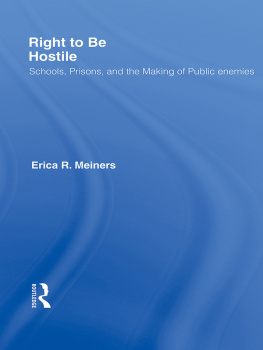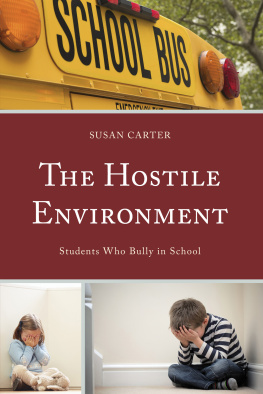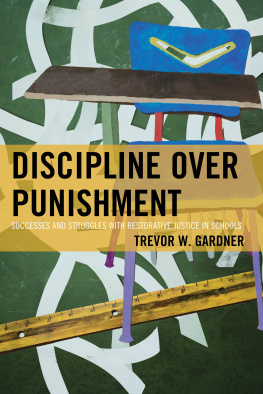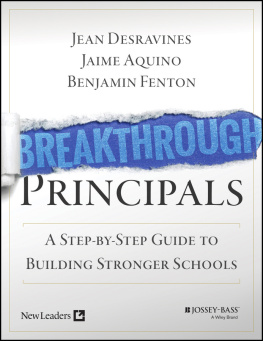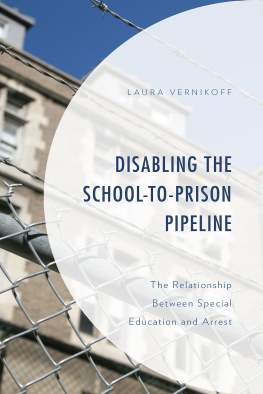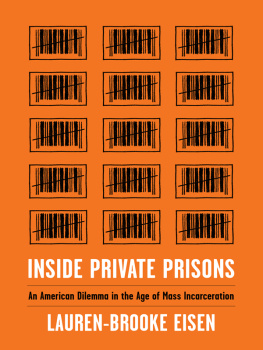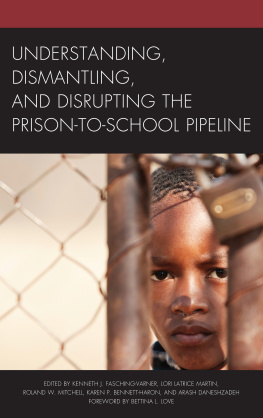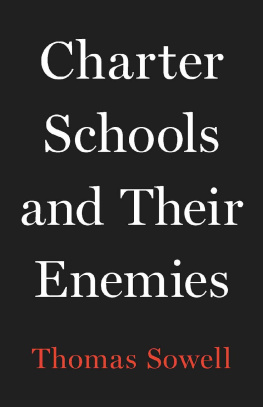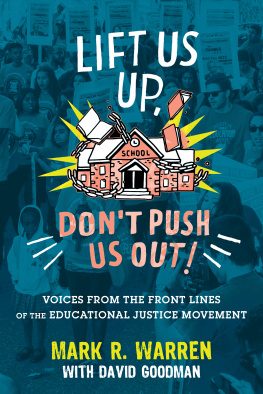Right to be HOSTILE
Right to Be HOSTILE
SCHOOLS, PRISONS, AND THE MAKING OF PUBLIC ENEMIES
Erica R. Meiners

New York London
Routledge
Taylor & Francis Group
270 Madison Avenue
New York, NY 10016
Routledge
Taylor & Francis Group
2 Park Square
Milton Park, Abingdon
Oxon OX14 4RN
2007 by Taylor & Francis Group, LLC
Routledge is an imprint of Taylor & Francis Group, an Informa business
This edition published in the Taylor & Francis e-Library, 2010.
To purchase your own copy of this or any of Taylor & Francis or Routledges collection of thousands of eBooks please go to www.eBookstore.tandf.co.uk.
ISBN 0-203-93645-0 Master e-book ISBN
International Standard Book Number-10: 0-415-95712-5 (Softcover) 0-415-95711-7 (Hardcover)
International Standard Book Number-13: 978-0-415-95712-0 (Softcover) 978-0-415-95711-3 (Hardcover)
No part of this book may be reprinted, reproduced, transmitted, or utilized in any form by any electronic,
mechanical, or other means, now known or hereafter invented, including photocopying, microfilming,
and recording, or in any information storage or retrieval system, without written permission from the
publishers.
Trademark Notice: Product or corporate names may be trademarks or registered trademarks, and are
used only for identification and explanation without intent to infringe.
Library of Congress Cataloging-in-Publication Data
Meiners, Erica R.
Right to be hostile : schools, prisons, and the making of public enemies / Erica
Meiners.
p. cm.
Includes bibliographical references.
ISBN 978-0-415-95711-3 (hb) -- ISBN 978-0-415-95712-0 (pb)
1. Critical pedagogy--United States. 2. Discrimination in education--United States.
3. Educational equalization--United States. 4. Social change--United States. I. Title.
LC196.M435 2006
370.115--dc22 2006031607
Visit the Taylor & Francis Web site at
http://www.taylorandfrancis.com
and the Routledge Web site at
http://www.routledge.com
Contents
Acknowledgments
This book was shaped through a number of projects and by working along-side people. Without the support and the challenges of these encounters and movements this book would not have been possible.
I thank the participants, teachers, and other community members at the St. Leonards Adult High School that I have worked with over the last six years for their humor, commitment, and labor including Mary Zangs, Kevin Glover, Robyn Clark, Renny Golden, Ajitha Reddy, James Hoskins, Bob Dougherty, Ken Addison, David Rutschman, Carla Lewis, Tanitha Dale, Willie Sallie, Roberto Sanabria, T. Manning, Mike Fitzgerald, Jitu Brown, and more recently, Mary Bandstra, Phyllis Porche, Eric Reyes, Karen Biegel, Erica Brown, Toussaint Losier, and Shelley Bannister. This community has been invaluable and sustaining, in particular Jean (Patricia) Hughes, who continues to show me that pragmatism can be radical and visionary and also full of humor and grace.
A number of other organizations in Chicago continue to be places where I learn, and all kinds of change happens, including Beyondmedia Education, Critical Resistance, Chicago Legal Advocacy for Incarcerated Mothers (CLAIM), and the Coalition for Education on Sexual Orientation (CESO). In addition, I have learned from people who resist prisons in a variety of ways including Yaki, Naoma Dye, Joanne Archibald, and Shaena Fazal.
I benefited from opportunities to workshop parts of this project in 2006. Specific thanks to Stephen Hartnett, Alison Bailey, Dawn Beichner, Char Hill, and the Education Graduate Student Association at Simon Fraser University, and to Leslie Bloom and Valerie Polakow. I thank David Gillborn and Bill Pinar for their support of my academic work over the years.
Therese Quinn, Leslie Bloom, Suzanne de Castell, and Ken Addison all offered smart feedback on parts of this manuscript as did reviewers from Routledge/Falmer and Susan Seals Giroux. If I did not take their suggestions, it is all my error, but their contributions enhanced this project. In addition, Catherine Bernard offered many generous but firm suggestions that improved the book, and, with kindness, Prudy Taylor Board and the staff made my writing better. Wajiha Khan and Anne Seveska provided invaluable research and bibliographic assistance.
Tim Barnett, and then Tyler Barnett Steinkamp, Scott Steinkamp, and now Erik Bataller, Mollie Dowling, and Nic McClellend make a joyously chaotic queer household. David Feiner and Laura Wiley continue to illustrate the value of a fierce, risky love and that art can be astonishing. Conversations and friendships with many made this project possible: Megan Bangs, Katherine Biers, Salome Chasnoff, Chris Cuomo, Marvin Garcia, Fong Hermes and family, Derrick Higginbotham, Nicole Holland, Francisco Ibez-Carrasco, Jodi Jensen, Katherine Lieber, Eleni Makris, Cage McCall, Fran Royster, Ann Russo, Karen Schlanger, Susan Tilley, Joan Varney, and Dave Stovall. Denise Meiners and Elena, Heather, Holly May and Stacia Middlemass continue to remind me of where I come from and the possibilities the future holds. Laurie Fuller offered her editing prowess, critical questions, reminders to get over myself, and crazy love.
This book is written in the early morning hours before my paid job at the university, before teaching, or when I place a note on my office door that I am in a conference call. I write between other commitments I have outside the university, on public transit, at the coffee shop on those beautiful mornings I am free, in my red room when there are no friends, or friends of friends, sleeping. I write this not to be special. I know people who are far busier than I, including my sister who has a traditional 8:30 a.m. to 5:30 p.m. job with less than two weeks of vacation a year. I am sure readers have similar, if not more compelling, constraints. My plea is not that I am special or extra busy, but rather this work is partial, and it reflects on going commitments to people and to projects that are always in progress. I fully expect and want next year to have new questions, to take new risks, and to learn more.
Finally, this book is for those hundreds of men and women with whom I have interacted who struggle to survive and to flourish and to make political and personal change amidst systems designed to annihilate.
Introduction
On March 19, 2004, at the Los Manos gallery in Chicago, site of Beyondmedias Voices in Time installation on gender, race, and incarceration, we were preparing for a 6 p.m. community forum on barriers to reentry for those formerly incarcerated. A group of African American students from Percy Julian High School finished their guided tour of the installation. The students were clearly engrossed by the video testimonies of women who survived and resisted prisons and jails in Illinois, the re-creation of the prison cell, and the materials such as uniforms and food that Beyondmedia Education had gathered. Also the data on the poster boards that charted the gendered and raced rising incarceration rate, the location of prisons in Illinois, and the boost to the local economies that prisons are purported to invigorate. An activist former prisoner and staff member of Chicago Legal Advocacy for Incarcerated Mothers (CLAIM) facilitated questions and led the group through this small exhibit. One female voice, toward the end, said:

